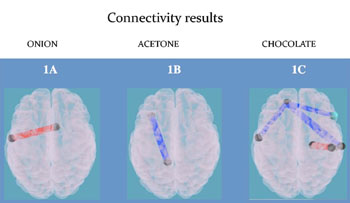Functional MRI Study Shows Child Obesity Has a Neurological Disorder Component
By MedImaging International staff writers
Posted on 09 Dec 2015
New Functional MRI research has shown that the impulse area of obese children’s brains is activated when they are introduced to food smells.Posted on 09 Dec 2015
The researchers found that the area of the brain associated with impulsivity and Obsessive-Compulsive Disorder (OCD) becomes active when the children were presented with various food smells, while other impulse-control areas of the brain showed no activity.

Image: The different connections found in the brains of normal weight children compared to those in obese children when presented with various food odors (Photo courtesy of RSNA).
The study is being presented at the annual meeting of the Radiological Society of North America (RSNA 2015). According to the US Centers for Disease Control and Prevention (CDC), nearly 12.7 million children in the US are obese, increasing their risk of developing health issues such as high blood pressure, type 2 diabetes, and breathing and joint problems, and of becoming obese adults.
Thirty children aged between 6 and 10 years took part in the study. Half had a normal Body Mass Index (BMI) from 19 to 24, while the other 15 children were obese with a BMI of more than 30. The children underwent functional Magnetic Resonance Imaging (fMRI) and functional connectivity MRI (fcMRI) exams to measure brain activity, and at the same time were presented with odors of chocolate, onion, and diluted acetone, a neutral smell.
The fMRI results showed that in obese children the food odors activated areas of the brain associated with impulse and OCD but no activity was observed in areas of the brain associated with impulse control. On the other hand, brain areas activated in those children with a normal BMI included areas associated with pleasure regulation, planning, organization, emotional processing or memory function. When researchers analyzed the fcMRI results, they found that children with a normal BMI also showed a connection between the gustatory cortex of the brain and the reward anticipation area, when presented with the onion odor. The fcMRI results for children with high BMI did not show this connection. In addition, the chocolate odor produced significant brain connections in obese children, compared to children with a normal BMI.
Pilar Dies-Suarez, MD, chief radiologist, Hospital Infantil de México Federico Gómez (Doctores, Mexico City, Mexico), said, "In order to fight obesity, it is crucial to understand the brain mechanisms of odor stimulus. This study has given us a better understanding that obesity has a neurological disorder component, and the findings have the potential to affect treatment of obese patients. If we are able to identify the mechanisms that cause obesity, we will be able to change the way we treat these patients, and in turn, reduce obesity prevalence and save lives.
Related Links:
Hospital Infantil de México Federico Gómez














